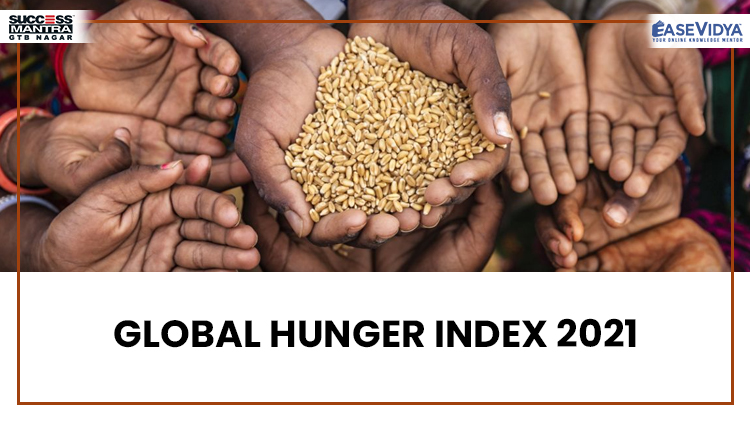
INDIA RANKED AT 101ST AT GLOBAL HUNGER INDEX 2021
INDIA RANKED AT 101ST AT GLOBAL HUNGER INDEX 2021
The 2021 Global Hunger Index (GHI) ranked India at 101st out of a total of 116 countries. The 2021 GHI report launched on October 14, 2021, stated that India with a score of 27.5 is facing a level of hunger that is serious. The Global Hunger Index released in 2020 ranked India at 94th among 107 countries. India has also been identified among the 31 countries where hunger has been identified as a serious threat. India has also ranked behind Pakistan (92nd rank), Bangladesh (76th rank), and Nepal (76th rank).
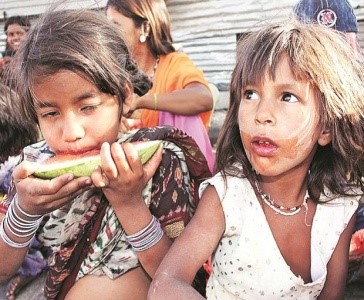
Current Affairs Notes By Success Mantra Coaching Institute GTB Nagar Delhi CLICK HERE
2021 GLOBAL HUNGER INDEX (GHI) – KEY POINTS
As per the current projections in the Global Hunger Index (GHI) report launched on October 14, 2021, it is estimated that the 47 countries in the world will be unable to achieve even low hunger by 2030. Although the GHI scores show that global hunger has declined since 2000, progress has slowed down. The GHI score on the global basis has fallen 4.7 points that is 25.1 to 20.4 points between 2006 and 2012. However, it has fallen just 2.5 points since 2012. Even after decades of decline, the global prevalence of undernourishment is increasing. This may be an indication of reversals in other measures of hunger.
Countries with extremely alarming and serious levels of hunger: As per the 2021 GHI report, Somalia has the highest level of hunger. With a score of 50.8 points, Somalia is facing extremely alarming levels of hunger. The other 5 countries with alarming levels of hunger are Yemen, Madagascar, the Democratic Republic of the Congo, Chad, and the Central African Republic. While 31 countries have shown serious levels of hunger, including India.
INDICATORS USED TO CALCULATE GHI 2021
Global Hunger Index uses four key indicators to measure progress toward Zero Hunger by 2030 at global, national and regional levels. Based on the four key indicators, the GHI assesses the level of hunger in a country on a 100-point scale wherein the score 100 is the worst (extreme hunger) and score 0 is the best (low or no hunger). The GHI score of each country is ascertained by severity, from low to extremely alarming.
For the 2021 Global Hunger Index (GHI), the four key indicators are:
- Undernourishment: the share of the population with insufficient caloric intake (data are from the UN Food and Agriculture Organization)
- Child stunting: the share of children under age five who have low height for their age (data are from UNICEF, the World Health Organization, the World Bank, and the Demographic and Health Surveys Program)
- Child wasting: the share of children under age five who have low weight for their height (data are from UNICEF, the World Health Organization, the World Bank, and the Demographic and Health Surveys Program)
- Child mortality: the mortality rate of children under age five (data are from the United Nations Inter-agency Group for Child Mortality Estimation)
2021 Global Hunger Index (GHI): Country-wise report - India
- As per the GHI report in 2021, India ranked 101st out of a total of 116 countries. With a score of 27.5, India is facing a serious level of hunger. Only 15 countries ranked worse than India. These countries are Papua New Guinea (102), Afghanistan (103), Nigeria (103), Congo (105), Mozambique (106), Sierra Leone (106), Timor-Leste (108), Haiti (109), Liberia (110), Madagascar (111), Democratic Republic of Congo (112), Chad (113), Central African Republic (114), Yemen (115) and Somalia (116).
- Progress of India on Global Hunger Index (GHI): India has shown significant progress on the GHI score since 2000. The country has witnessed a decrease in the GHI score of 38.8 points (extreme hunger) in 2000 to 27.5 points (serious hunger) in 2021. However, child nutrition remains an area of concern for India.
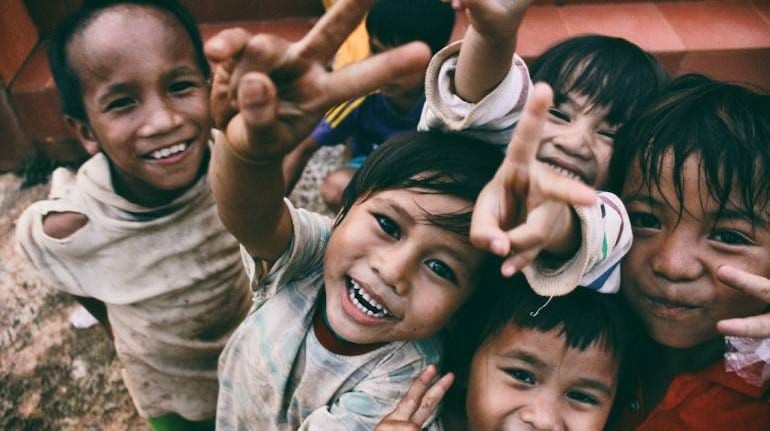
ABOUT THE GLOBAL HUNGER INDEX
- Annual Report: Jointly published by Concern Worldwide and Welthungerhilfe. It was first produced in 2006. It is published every October. The 2021 edition marks the 16th edition of the GHI.
- Aim: To comprehensively measure and track hunger at the global, regional, and country levels.
- Data Collection: Undernourishment data are provided by the Food and Agriculture Organisation and child mortality data are sourced from the UN Inter-agency Group for Child Mortality Estimation (UN IGME).
- Child wasting and stunting data are drawn from the joint database of UNICEF, the World Health Organization (WHO) and the World Bank, among others.
- Global Scenario: The fight against hunger is dangerously off track. Based on current GHI projections, the world as a whole - and 47 countries in particular - will fail to achieve a low level of hunger by 2030. Food security is under assault on multiple fronts. Worsening conflict, weather extremes associated with global climate change, and the economic and health challenges associated with the Covid-19 pandemic are all driving hunger. After decades of decline, the global prevalence of undernourishment - a component of the Global Hunger Index - is increasing. This shift may be a leading indicator of reversals in other measures of hunger. Inequality - between regions, countries, districts, and communities - is pervasive and, left unchecked, will keep the world from achieving the Sustainable Development Goal (SDG) mandate to “leave no one behind”. Africa, South of the Sahara and South Asia are the world regions where hunger levels are highest. Hunger in both regions is considered serious.
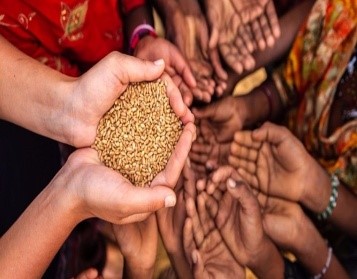
INDIAN SCENARIO
Since 2000, India has made substantial progress, but there are still areas of concern, particularly regarding child nutrition. India’s GHI score has decreased from a 2000 GHI score of 38.8 points - considered alarming - to a 2021 GHI score of 27.5 - considered serious. The proportion of undernourished in the population and the under-five child mortality rate are now at relatively low levels. While child stunting has seen a significant decrease - from 54.2% in 1998-1999 to 34.7% in 2016-2018 - it is still considered very high. At 17.3%, India has the highest child wasting rate of all countries covered in the GHI. This rate is slightly higher than it was in 1998-1999, when it was 17.1%. According to the Index, only 15 countries are worse than India. India was also behind most of the neighbouring countries. Pakistan was placed at 92, Nepal and Bangladesh at 76 and Sri Lanka at 65.
Government of India Stand: The Ministry of Women and Child Development has criticised the report claiming that the methodology used by FAO is unscientific. According to the Government, the Global Hunger Index Report 2021 and FAO report on ‘The State of Food Security and Nutrition in the World 2021’ have completely ignored the following facts: They have based their assessment on the results of a ‘four question’ opinion poll, which was conducted telephonically by Gallup. The scientific measurement of undernourishment would require measurement of weight and Height, whereas the methodology involved here is based on a Gallup poll, based on a pure telephonic estimate of the population. The report completely disregards Government’s massive effort to ensure food security of the entire population during the Covid period such as Pradhan Mantri Garib Kalyan Anna Yojna (PMGKAY) and Aatmanirbhar Bharat Scheme (ANBS).
SOME RELATED INITIATIVES BY INDIA
- Eat Right India Movement: An outreach activity organised by the Food Safety and Standards Authority of India (FSSAI) for citizens to nudge them towards eating right.
- POSHAN Abhiyan: Launched by the Ministry of Women and Child Development in 2018, it targets to reduce stunting, undernutrition, anemia (among young children, women and adolescent girls).
- Pradhan Mantri Matru Vandana Yojana: A centrally sponsored scheme executed by the Ministry of Women and Child Development, is a maternity benefit programme being implemented in all districts of the country with effect from 1st January, 2017.
- Food Fortification: Food Fortification or Food Enrichment is the addition of key vitamins and minerals such as iron, iodine, zinc, Vitamin A & D to staple foods such as rice, milk and salt to improve their nutritional content.
- National Food Security Act, 2013: It legally entitled up to 75% of the rural population and 50% of the urban population to receive subsidized food grains under the Targeted Public Distribution System.
- Mission Indradhanush: It targets children under 2 years of age and pregnant women for immunization against 12 Vaccine-Preventable Diseases (VPD).
- Integrated Child Development Services (ICDS) Scheme: Launched on 2nd October, 1975, the ICDS Scheme offers a package of six services (Supplementary Nutrition, Pre-school non-formal education, Nutrition & health education, Immunization, Health check-up and Referral services) to children in the age group of 0-6 years, pregnant women and lactating mothers.
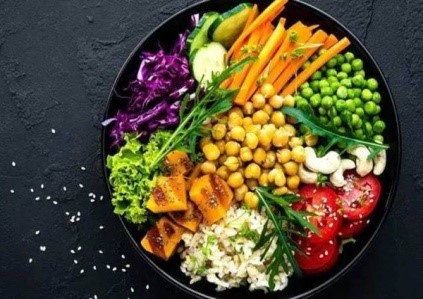
PRAVAHINI Current Affairs Notes By Success Mantra Coaching Institute GTB Nagar Delhi CLICK HERE
TEST YOURSELF
Q.1 Global Hunger Index report 2020 is co-published by which of the following institutions?
- US based International Food Policy Research Institute (IFPRI)
- Germany-based Welthungerhilfe
- Irish NGO Concern Worldwide
- Both B & C: ANSWER
Q.2 Consider the given statements & state which of the following is/are correct in the context of the above-mentioned passage?
- The Global Hunger Index released in 2020 ranked India at 104th among 107 countries.
- According to the Index, only 15 countries are worse than India. India was also behind most of the neighbouring countries such as Pakistan, Nepal and Bangladesh.
- Only I follows
- Only II follows: ANSWER
- Both I & II follows
- None of the following
Q.3 Global Hunger Index report 2020 is calculated on the basis of four factors. Which of the following is not one of these?
- Undernourishment
- Child Stunting
- Child Abuse: ANSWER
- Child Mortality
Q.4 What is the India's rank in the Global Hunger Index 2020 in which data were assessed for the 132 countries and GHI scores were calculated for only 107 countries?
- 96TH Rank
- 85TH Rank
- 91ST Rank
- 101ST Rank: ANSWER
Q.5 From the following options, which of the following is not an initiative started by the Government of India to combat Hunger?
- Mission Shakti: ANSWER
- Mission Indradhanush
- Poshan Abhiyan
- Eat right India movement












0 Comment